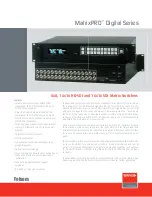
2-2
Table 2-1
Working environment
Item
Specification
Temperature
0°C to 45°C (32°F to 113°F)
Relative humidity
10% to 95% (noncondensing)
Cleanliness
Dust is hazardous to the operating safety of the device. Dust buildup on the chassis may result in static
adsorption, causing poor contact of metal connectors or metal contact points. When the relative indoor
humidity is low, especially, electrostatic adsorption is more likely to happen. This not only shortens the
service life of your device but also causes communication failures. The following table lists the dust
concentration limit in the equipment room.
Table 2-2
Dust concentration limit in the equipment room
Physical active substance
Limit (particles/m
3
)
Dust particles
≤
3 × 10
4
(No visible dust on the tabletop over three days)
Note: The dust particle diameter is
≥
5
μ
m
In addition, the equipment room should also meet the rigorous limits on salts, acids, and sulfides to
eliminate corrosion and premature aging of some parts. Table 2-3 lists the limits on harmful gases in the
equipment room.
Table 2-3
Limit on harmful gases in the equipment room
Gas
Limit (mg/m
3
)
SO
2
0.2
H
2
S 0.006
NH
3
0.05
Cl
2
0.01
ESD Prevention
Static electricity generation and harms
The electrostatic induction that adversely affects the operation of the device mainly comes from:
z
Outdoor electric fields caused by high-voltage power lines or lightning strikes.
z
Internal systems, such as the indoor environment, floor materials, and the structure of the
integrated equipment.
Although a great deal of electrostatic discharge (ESD) prevention considerations have been taken in
the design of the WX3000 series, excessive static electricity is still remarkably harmful to the whole
device.
ESD prevention methods
To prevent ESD damage, do the following:
















































